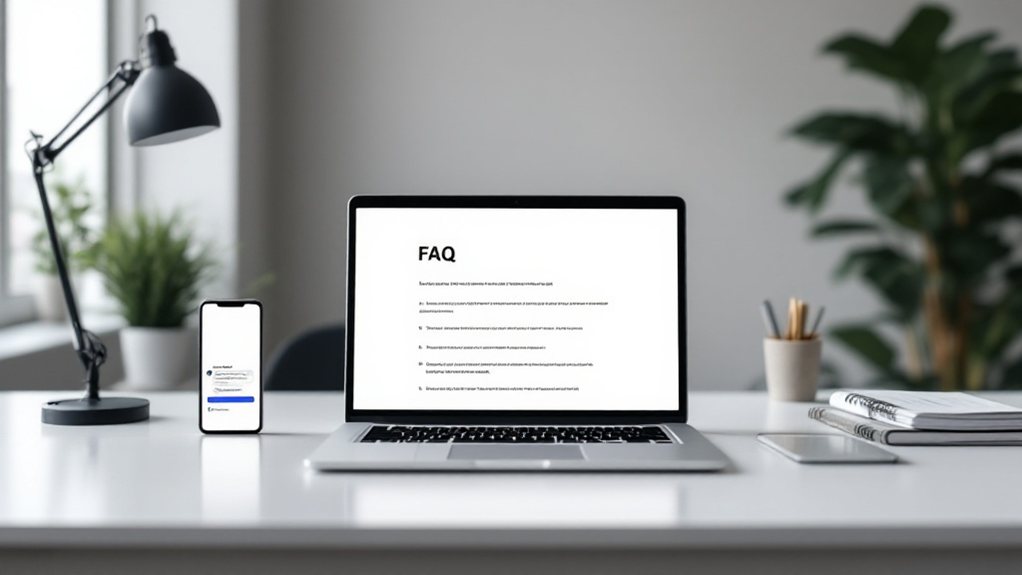Craft compelling FAQ pages that strengthen your local SEO by gathering customer interaction data, analyzing search intent, and engaging support agents. Use plain language and visual aids to address complex topics. Organize FAQs for optimal structure and navigation, while designing for accessibility and mobile-friendliness. Optimizing your FAQs can provide sales and SEO benefits – continue reading to learn more.
Leveraging Customer Interaction Data

When you leverage customer interaction data, you can gain valuable insights to build relevant FAQs that address your audience's concerns. Gather data from various channels like live chat, support tickets, social media, and email. Identify recurring issues to create FAQs that solve them. Organize the data using spreadsheets and leverage analytics tools to find patterns. Regularly incorporate customer feedback to keep your FAQs current and effective. By tapping into this wealth of information, you can develop a comprehensive FAQ section that truly resonates with your customers. Leveraging customer interaction data can also help reinforce your business's Name, Address, and Phone (NAP) information on your FAQ page.
Analyzing Search Intent and Customer Needs

Analyzing search intent and understanding customer needs go hand-in-hand when crafting effective FAQ pages. By identifying the primary types of search intent – informational, navigational, transactional, and commercial investigation – you can create content that addresses your customers' specific needs. Understanding the customer journey is essential for leveraging search intent data. Leverage tools like Moz Pro to label keywords by intent, and examine search engine results pages to understand the dominant intent behind queries. Uncover customer pain points through forums and user-generated content. Then, optimize your FAQ pages accordingly – informational content for educational searches, navigational pages for brand-focused queries, transactional pages with clear calls-to-action, and in-depth product comparisons for commercial investigation.
Engaging With Support Agents for Insights

Effective FAQ pages are built on a foundation of close collaboration with customer support teams. By facilitating regular communication, you can harness the insights of agents who directly engage with your customers. Effective FAQ pages are built on a foundation of close collaboration with customer support teams to ensure the FAQ content accurately reflects customer needs and concerns.
- Leverage support data to identify recurring questions and pain points. Analyze ticket logs and interaction records to surface the most common inquiries, then prioritize them in your FAQ.
- Integrate live support options to complement your self-service resources. Seamless access to knowledgeable agents ensures customers can find the answers they need, even for complex issues.
- Establish a continuous feedback loop, regularly reviewing the FAQ with support teams and incorporating user suggestions. This maintains relevance and builds trust by keeping your content aligned with evolving customer needs.
Crafting Questions in Plain Language
When crafting FAQ questions, it's crucial to mirror the language and expressions your customers use. This helps ensure your FAQs address the varying search intents of your audience. By keeping your questions simple and straightforward, you'll reinforce your NAP (name, address, phone) information and make it easy for users to find the answers they need. Organizing information to serve the reader's needs is key to crafting effective FAQ pages.
Mirroring Customer Expressions
Mirroring customer expressions goes beyond simply rephrasing their words – it's about capturing the essence of how they communicate. By adopting a similar tone, vocabulary, and even body language, you can create a sense of familiarity and trust. This not only encourages customers to express their needs openly but also demonstrates your genuine understanding of their perspective.
Mirroring can happen subconsciously or consciously through active listening. It helps establish an immediate connection by making customers feel heard and understood. It ensures your FAQs are approachable and relatable, aligning with the customer's communication style. It fosters empathy, as the mirrored gestures and tone convey a deeper level of engagement.
Effective mirroring requires a delicate balance, but when done right, it can significantly enhance the customer experience.
Addressing Varying Search Intent
Crafting questions in plain language is crucial for addressing varying search intent on your FAQ pages. By using simple, straightforward language, you can ensure your FAQs are accessible to users with different types of queries. For informational intent, start questions with “what,” “how,” or “why” to provide clear, concise information. For commercial intent, incorporate words like “best,” “reviews,” and “top-rated” to help users compare products. When addressing transactional intent, be specific about the actions users can take, such as “How do I order [product] online?” Avoid overly technical terms and focus on addressing common pain points. Additionally, tailor questions to include local and expert insights to further meet user needs.
Incorporating Visual Aids for Complex Topics
Visual aids can be a powerful tool in simplifying complex concepts and enhancing engagement with your FAQ pages. By breaking down intricate ideas into understandable visual formats, you can make them easier to grasp. Additionally, visuals tap into the human brain's natural affinity for processing images, allowing for faster comprehension and better retention. Visual communication can break down complex topics into easy-to-remember analogies to further reinforce your FAQ information.
Consider incorporating these three types of visual aids to elevate your FAQ pages:
- Infographics: Effective in presenting data and facts in a visually appealing manner.
- Diagrams: Helpful in explaining processes or technical details related to your FAQs.
- Videos: Can integrate audio and visual elements to provide dynamic and engaging explanations for complex FAQs.
Leveraging the right visual aids can make your FAQ pages more accessible, memorable, and impactful for your audience.
Prioritizing Frequently Asked Questions
To ensure your FAQ page is effective, you should identify the high-volume queries your customers frequently ask. Additionally, address any common objections or concerns they may have. By prioritizing these frequently asked questions, you can provide the most relevant information to reinforce your NAP details. Determining Prioritization Criteria can help you effectively manage competing priorities and organize your task list.
Identify High-Volume Queries
Identifying high-volume queries is crucial when prioritizing frequently asked questions (FAQs) on your website. By analyzing customer feedback, social media themes, and support ticket patterns, you can pinpoint the most common issues customers face. Additionally, monitoring FAQ page utilization and performing SEO keyword analysis will reveal the topics customers frequently search for. These insights will help you focus your efforts on the FAQs that matter most to your audience. Effective prioritization ensures urgent issues are addressed quickly.
- Review customer feedback forms to uncover recurring issues.
- Observe social media discussions for frequently mentioned topics.
- Analyze support tickets to identify common problems customers encounter.
Address Common Objections
Addressing common objections through your FAQ pages is a crucial step in reinforcing your business's authority and credibility. FAQs can address misconceptions, credibility issues, complexity, competitor comparisons, and future support. To handle price and value objections, focus on pricing transparency, value proposition, comparative cost analysis, ROI expectations, and payment flexibility. Emphasize the importance of using customer testimonials and case studies to demonstrate the product's value. When managing fear of change objections, emphasize change justification, risk assessment, transition support, case studies, and long-term benefits. To overcome lack of need objections, identify hidden needs, highlight unique selling propositions, solve problems, provide educational resources, and share customer stories.
| Common Objections | Price and Value Objections | Fear of Change Objections |
|---|---|---|
| Misconceptions | Pricing Transparency | Change Justification |
| Credibility Issues | Value Proposition | Risk Assessment |
| Complexity | Comparative Cost Analysis | Transition Support |
Addressing Industry-Related and Objection-Based Queries
As a business owner, it's crucial to anticipate and address industry-specific questions that your customers may have. This includes:
- Clarifying common misconceptions about your industry or services.
- Comparing your offerings to competitors in a transparent manner.
- Discussing how technological advancements impact your business operations.
Furthermore, be prepared to handle objection-based queries, such as concerns about trust, cost, and product/service effectiveness. By providing transparent information on your policies, legal compliance, and customer support, you can build confidence and reinforce your business's credibility.
Organizing FAQs for Optimal Structure and Navigation
Once you've addressed industry-specific queries and handled customer objections, the next step is to organize your FAQ page for optimal structure and navigation. Group related questions by topic, listing them in order of frequency to prioritize common issues. Use clear category titles, and consider chronological or alphabetical sorting to aid navigation. Incorporate search bars, collapsible sections, and strategic use of headings, bullet points, and hyperlinks to enhance user experience. Regularly update the content to maintain relevance, and ensure answers are clear, concise, and tailored to your audience's communication preferences. By aligning your FAQ structure with customer needs, you'll create a valuable resource that reinforces your NAP information.
Designing for Accessibility and Mobile-Friendliness
Designing a user-friendly FAQ page that caters to accessibility needs and mobile responsiveness is crucial for ensuring a seamless experience for all visitors. Comply with key accessibility guidelines, such as:
- Ensure screen reader compatibility and provide descriptive alt text for images to assist visually impaired users.
- Enable keyboard navigation and maintain sufficient color contrast to accommodate users with limited mobility or visual impairments.
- Include transcripts or captions for multimedia content to support users with hearing or visual disabilities.
Additionally, optimize the FAQ page for mobile devices by implementing responsive design, touch-friendly navigation, and fast loading times. By prioritizing accessibility and mobile-friendliness, you can create an inclusive and user-centric FAQ experience that resonates with diverse audiences.
Optimizing FAQs for Sales and SEO Benefits
Optimizing your FAQs for sales and SEO should be a top priority. Crafting FAQs that engage customers and boost conversions is crucial. Highlight product benefits, address key objections, and gather feedback to enhance relevance. Integrate target keywords and schema markups to improve search visibility. Optimize title tags and meta descriptions, and link FAQs to relevant content. This will drive traffic, enhance user experience, and give you a competitive edge. Leverage FAQs for voice search, content creation, and product development insights. Ultimately, comprehensive, SEO-friendly FAQs can reduce customer queries, increase loyalty, and reinforce your business's NAP information across the web.
